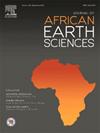Petrogenesis of late Cretaceous granitoids in Gemici (Elazığ-Türkiye): evidence from whole-rock geochemistry, Sr–Nd isotopes, zircon U–Pb dating, and trace elements
IF 2.2
4区 地球科学
Q2 GEOSCIENCES, MULTIDISCIPLINARY
引用次数: 0
Abstract
The late Cretaceous granites and granodiorites are exposed in the Gemici area of Elazığ Province (eastern Türkiye). Here, we present recent whole-rock major oxide, trace element and Sr–Nd isotopic analyses, as well as zircon U–Pb data and trace element data of granitoids from the Southeastern Anatolian Orogenic Belt (SAOB) in eastern Türkiye. This paper aims to investigate the petrogenesis of the late Cretaceous granite and granodiorites (Gemici/Elazığ) using new and previously existing geochemical and geochronological data. Geochemical data indicate that the studied granites and granodiorites vary in composition from metaluminous to peraluminous, exhibit tholeiitic-calc-alkaline characteristics, and belong to the I-type granite. m. The Th/U ratios of zircon grains suggest a magmatic origin. Negative Eu and positive Ce values in zircon grains are indicative of unaltered magmatic zircons. The studied rocks exhibit a narrow range of 87Sr/86Sr(i) ratios (0.704369–0.706019), and εNd(t) values vary from 2.9 to 6.2, yielding model ages (TDM) ranging from 841 to 1421 Ma. The energy-constrained assimilation-fractional crystallization (EC-AFC) modelling shows that the studied granite and granodiorites contain 1 %–5 % crustal melt contributions. Geochemical data indicate that subduction zone magmatism plays an active role in the petrogenesis of the studied rocks.
Gemici晚白垩世花岗岩类岩石成因(Elazığ-Türkiye):全岩地球化学、Sr-Nd同位素、锆石U-Pb测年和微量元素证据
在Elazığ省(东基耶)Gemici地区出露晚白垩世花岗岩和花岗闪长岩。本文对东安纳托利亚造山带(SAOB)花岗岩类进行了全岩主氧化物、微量元素和Sr-Nd同位素分析,以及锆石U-Pb数据和微量元素数据。本文旨在利用新的和已有的地球化学和年代学资料研究晚白垩世花岗岩和花岗闪长岩(Gemici/Elazığ)的岩石成因。地球化学资料表明,所研究的花岗岩和花岗闪长岩组成由铝质到过铝质不等,具有拉斑-钙碱性特征,属于i型花岗岩。m.锆石颗粒Th/U比值显示岩浆成因。锆石颗粒中Eu值为负,Ce值为正,表明锆石为未蚀变岩浆锆石。研究岩石87Sr/86Sr(i)比值范围较窄(0.704369 ~ 0.706019),εNd(t)值在2.9 ~ 6.2之间,模型年龄(TDM)在841 ~ 1421 Ma之间。能量约束同化-分数结晶(EC-AFC)模型表明,所研究的花岗岩和花枝闪长岩含有1% - 5%的地壳熔体贡献。地球化学资料表明,俯冲带岩浆作用在岩石成因中起着积极作用。
本文章由计算机程序翻译,如有差异,请以英文原文为准。
求助全文
约1分钟内获得全文
求助全文
来源期刊

Journal of African Earth Sciences
地学-地球科学综合
CiteScore
4.70
自引率
4.30%
发文量
240
审稿时长
12 months
期刊介绍:
The Journal of African Earth Sciences sees itself as the prime geological journal for all aspects of the Earth Sciences about the African plate. Papers dealing with peripheral areas are welcome if they demonstrate a tight link with Africa.
The Journal publishes high quality, peer-reviewed scientific papers. It is devoted primarily to research papers but short communications relating to new developments of broad interest, reviews and book reviews will also be considered. Papers must have international appeal and should present work of more regional than local significance and dealing with well identified and justified scientific questions. Specialised technical papers, analytical or exploration reports must be avoided. Papers on applied geology should preferably be linked to such core disciplines and must be addressed to a more general geoscientific audience.
 求助内容:
求助内容: 应助结果提醒方式:
应助结果提醒方式:


